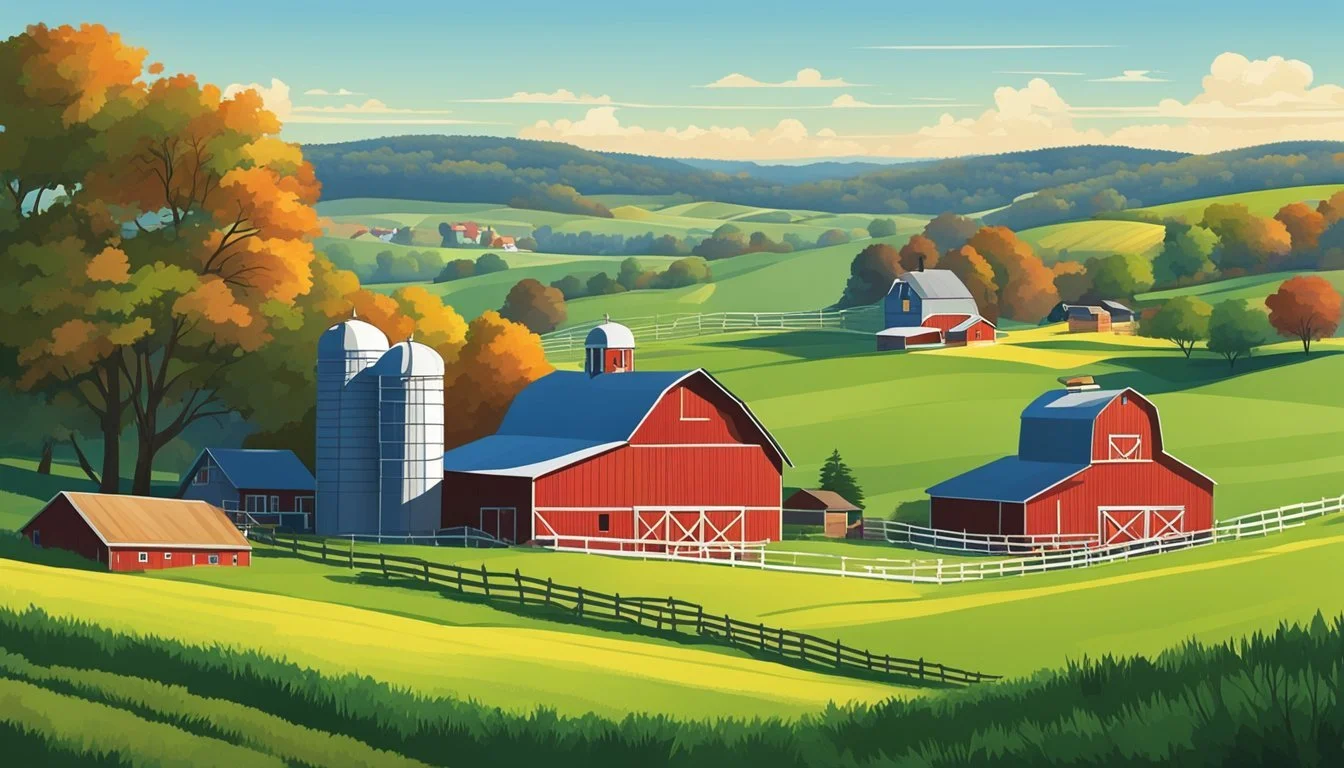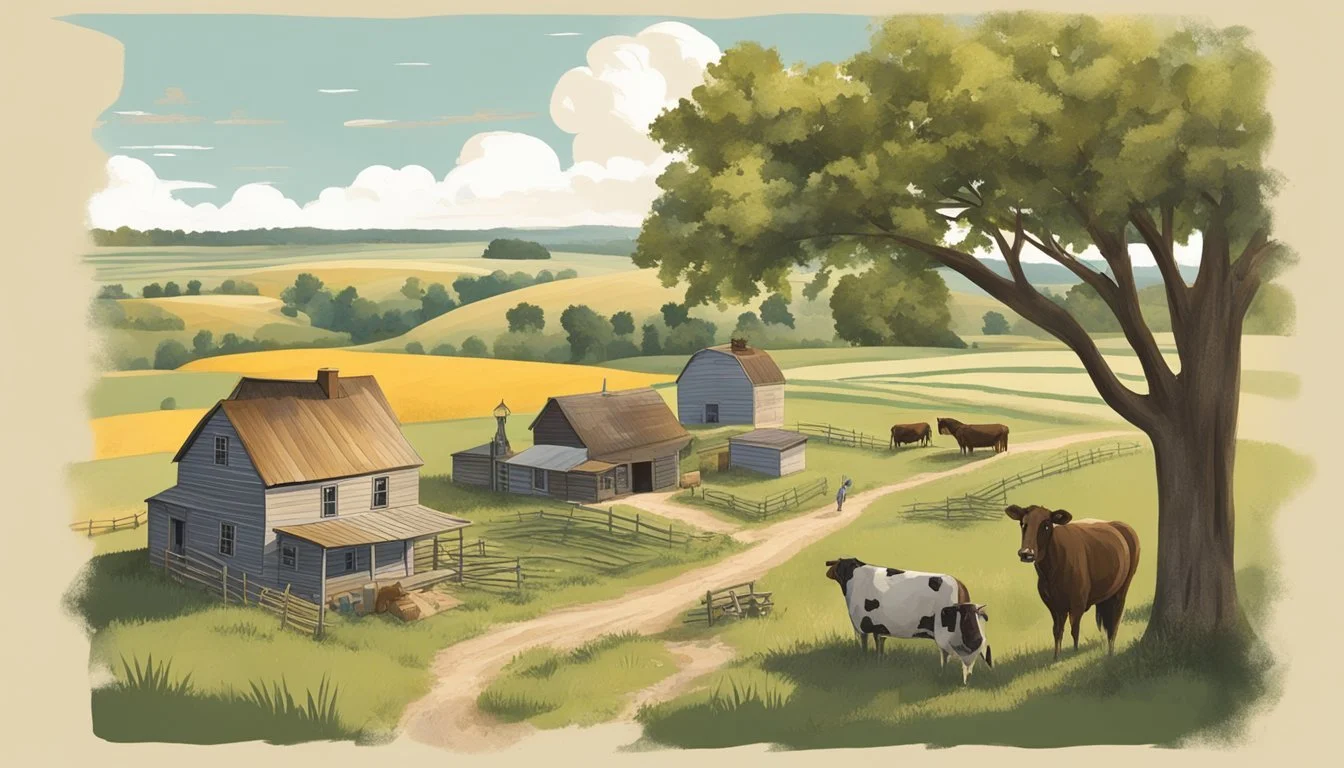Right to Farm Law in Missouri
Understanding Agricultural Protections
The Right to Farm Law in Missouri stands as a testament to the state's commitment to safeguarding its agricultural practices. Enshrined in Missouri's constitution through Amendment 1, which passed in the August 5, 2014 primary election, the law establishes an enduring principle that agriculture, with its pivotal role in providing food, energy, and health benefits, forms the core of Missouri’s economy. The law aims to protect Missouri farmers and ranchers from undue legislative changes, ensuring that agricultural operations can continue without the fear of being undermined by future laws that could threaten their practices.
Legal challenges against farming practices are not uncommon, and the Right to Farm Law equips Missouri agriculturists with a constitutional shield against nuisance lawsuits. Prior to this amendment, local governments had a degree of flexibility to regulate agricultural operations. Post adoption of the Right to Farm law, this flexibility is somewhat curtailed, implying that the standardized protection offered by the law now supersedes certain forms of local government regulation. The law's lack of specific mention on how local governments can regulate agricultural operations leaves that area somewhat open to interpretation, although other statutes provide context for its application.
Missouri's legislation sends a clear message of support to the agricultural community by reinforcing the idea that farming and ranching are vital, not just to the state's economy, but also to the well-being of its residents. While the adoption of the Right to Farm Law has confirmed the state's standing on agricultural rights, the debate over the balance between agricultural protection and local regulation continues, reflecting the complexities inherent in legislating the nuances of agricultural practices.
Historical Context and Constitutional Backdrop
This section will discuss the development of Right to Farm laws in the United States and specifically focus on how this concept was solidified within Missouri's state constitution.
Origins of Right to Farm Laws
Right to Farm laws surfaced in the United States as a defense mechanism for agricultural operations. These laws are designed to protect farmers from nuisance lawsuits that may arise when lawful farming operations negatively affect nearby properties, for instance, through odor or noise. Missouri is among all fifty states that have enacted some form of Right to Farm legislation to safeguard these agricultural activities.
Missouri's Constitutional Amendment Process
Missouri's Constitutional Amendment regarding the Right to Farm was a significant milestone, providing enduring security for the state's agricultural sector. The amendment, known as Section 35, was embedded within Article I of the Missouri Constitution. This constitutional directive ensures that farming in Missouri, which contributes to food production, energy, health, and economic stability, is recognized as a fundamental right. The amendment process engaged public discourse and voting, reflecting a democratic approach to modifying the state's constitution. It underlined the importance of agriculture as the stabilizing force in Missouri's economy and was designed to withstand the test of time against regulatory changes that could impede on farming practices.
Overview of Missouri's Right to Farm Law
Missouri has codified protections for agricultural operations through legislative and constitutional means, ensuring the ability of farmers and ranchers to continue their practices with legal backing.
Summary of Amendment 1
Amendment 1, known as Missouri's Right to Farm, passed on August 5, 2014, by a narrow margin. The measure was placed on the ballot as a constitutional amendment and was subsequently ratified, making Missouri one of the few states to enshrine the Right to Farm in its state constitution. The amendment's passage meant formal acknowledgment for the importance of agriculture in Missouri's economy and culture, solidifying the rights of farmers and ranchers.
Fundamental Provisions in Section 35
Section 35 of Missouri's statutes precisely articulates the guarantees provided by the Right to Farm. It declares that agriculture, which supplies food, energy, health benefits, and security, is foundational to the state's economy. Farming and ranching practices are not only protected but forever guaranteed, according to the language of the statute. This law limits the ability of neighboring property owners to claim non-economic damages due to nuisances originating from agriculturally zoned land, essentially providing a shield for standard agricultural operations.
Implications for Farmers and Ranchers
The Right-to-Farm laws in Missouri have set a precedent that secures the rights of farmers and ranchers to continue their livelihood through established agricultural practices. This legislation has far-reaching effects on how these individuals conduct their operations on a daily basis.
Impacts on Daily Farming Operations
Farmers in Missouri can expect minimal intervention from local governments when it comes to their daily operations due to the Right-to-Farm law. The law does not directly specify the extent of local governmental regulation. This has led to a generalized understanding that as long as farmers adhere to standard farming practices, their autonomy in making operational decisions is upheld. This includes decisions regarding:
Planting and harvesting schedules
Selection and application of fertilizers and pesticides
Implementation of soil and water conservation measures
Farmers can operate with the confidence that their standard practices in cultivating crops, managing fields, and maintaining farm infrastructure are legally protected.
Ranching Practices and Animal Husbandry
For ranchers, the law's implications extend to the realm of ranching practices and animal husbandry. Missouri's Right-to-Farm legislation ensures that ranchers have the right to raise and manage livestock, including cattle, pigs, poultry, and other farm animals, without facing undue regulatory burdens. Ranchers can perform standard ranching operations such as:
Breeding and raising of livestock
Feeding and nutrition management
Implementation of animal health protocols
This law underlines Missouri's commitment to protect what it considers a vital sector of its economy by persisting in the guarantee for ranchers to perform these practices. It reinforces the state's stature as a place where ranching can be conducted without fear of abrupt legal challenges to these aspects of their work.
Legal Challenges and Interpretations
Missouri's Right-to-Farm laws have seen various legal challenges, questioning the extent of their reach and setting significant legal precedents, while raising the issue of how local governments may regulate agricultural operations.
Notable Court Cases and Legal Precedents
Missouri's Right-to-Farm laws have been subjected to interpretation by the judiciary, particularly in cases where they have clashed with local regulations and community interests. A key case was Labrayere v. Bohr Farms, where the Missouri Supreme Court played a crucial role in upholding the agricultural protections against nuisance damages. This case affirmed the Right-to-Farm statute, specifically Missouri Revised Statutes section 537.296, demonstrating the state’s commitment to protecting agricultural operations from undue legal challenges.
Another pivotal moment came with an amendment to the Missouri Constitution through Amendment 1 in August 2014. It aimed to protect farmers and ranchers from the evolving legal landscape and challenges that might compromise farming and ranching practices. Subsequently, legal challenges post the amendment have also tested its strength and reach. The result of a narrow approval margin for Amendment 1 also led to a recount, signifying the divided stance on the issue and its high-stakes impact on Missouri's agricultural law.
The Role of Local Government and Ordinances
The interaction between Missouri's Right-to-Farm laws and local government authorities has been a grey area leading to legal confrontations. Local governments had some discretionary power to pass their own ordinances affecting agricultural practices. However, post the 2019 Right-to-Farm law amendments, the specific role of local governments became less clear. Other existing laws provide context to the authorized powers local governments have, detailing the limits and reaches of the Right-to-Farm laws.
While the state law does not explicitly limit local governments from regulating agriculture, it does present a complex legal landscape where the extent of local oversight versus the state’s right-to-farm protections often comes into question. Legal challenges continue to shape the dialogue between state interests in supporting agriculture and local entities' interests in health, environment, and zoning.
Agricultural Practices and Environmental Concerns
Missouri's Right to Farm laws endeavor to support farming practices while addressing the concerns surrounding environmental health and public welfare. These laws involve not only the safeguarding of agricultural operations but also carry implications for environmental policy and public health.
Balancing Farm Operations and Public Health
Agricultural operations in Missouri, particularly Concentrated Animal Feeding Operations (CAFOs), are pivotal for food production but pose challenges for public health. The balance between farm productivity and public health is delicate; issues such as odor, noise, and waste management impact nearby residents. Policies must ensure farm operations do not compromise air and water quality, which are critical for community health.
Nuisance Suits and Environmental Impact
Missouri law aims to protect farmers from nuisance suits—legal challenges brought by individuals or communities impacted by agricultural operations. However, the potential for pollution and other environmental concerns stemming from these operations necessitates a framework that addresses both the rights of farmers and environmental protection. The law seeks to prevent agricultural operations from being deemed a nuisance if they adhere to established regulations and practices, although this sometimes leads to contention with environmental advocacy.
Economic and Social Impact
Missouri's Right to Farm laws significantly influence both its economy and social structures, especially within rural communities and systems related to food distribution.
Contribution to Missouri's Economy
Missouri's robust agricultural sector is a cornerstone of its economy. The state's farmland not only yields a variety of crops but also supports the production of essential livestock products. The adoption of Right to Farm laws has been pivotal in safeguarding these activities, which collectively contribute to the state's financial health.
Farmland: Over 10 million acres devoted to soybeans, (how long do soybeans last?) corn, and other vital crops.
Livestock Products: Major producer of beef, pork, and dairy, with billions of dollars in economic output.
These components ensure that agriculture remains a significant contributor to Missouri's Gross Domestic Product (GDP).
Rural Communities and Farm-to-Table Initiatives
The Right to Farm laws foster more than just economic stability; they greatly benefit social dynamics in Missouri. In rural areas, this legislation supports the livelihoods of communities by providing a degree of certainty to farmers and ranchers.
Community Engagement: Strengthened ties through local support of agriculture.
Farm-to-Table: Promotion of local food networks enhances the distribution and availability of fresh produce.
Beyond enriching the local food culture, these initiatives reinforce the social fabric by bridging the gap between producers and consumers.
Controversies and Opposition
The Right to Farm laws in Missouri have sparked significant debate and dissent. Critics raise major concerns about the implications for animal rights, human health, and the livelihood of small farmers and local residents.
Animal Rights and Human Health Advocacy
Animal rights groups, including the Humane Society of the United States, argue that Right to Farm laws in Missouri may hinder efforts to enact more stringent animal welfare standards. These groups assert that the laws could protect industrial farming practices, which often prioritize production over the welfare of animals. Public health advocates also weigh in, suggesting that lax regulations on farming practices may pose risks to human health through potential impacts on food safety and the use of agricultural chemicals.
Concerns Include:
Obstructing animal welfare reforms
Potential risks to food safety
Impact of chemical use on public health
Criticism from Residents and Small Farmers
Residents and small farmers have voiced criticism against the Right to Farm amendment. They claim that the amendment disproportionately benefits large agricultural corporations over independent farmers. As residential critics point out, increased industrial farming activities might lead to environmental challenges that affect the quality of life in rural communities.
Key Points of Criticism:
Disproportionate benefit to large agribusinesses
Environmental concerns for local communities
Threat to the viability of small-scale farming operations
Critics from both groups, residents and small farmers, argue that these laws could limit local governance and the ability for communities to advocate for their environmental and economic interests.
Statewide and National Comparisons
This section examines Missouri's Right to Farm laws in the context of other state legislations and the broader legal landscape in the United States, drawing comparisons to highlight similarities and differences.
Comparing Missouri Laws with Other States
Missouri stands out in its legal approach to agriculture by having its Right to Farm (RTF) law embedded in the state constitution, a distinction it shares with only North Dakota. This constitutional amendment, passed by a narrow margin in 2014, secures the rights of farmers and ranchers to engage in agricultural practices. While many Midwestern states have RTF statutes, Missouri's constitutional amendment provides a unique level of legal affirmation.
Other states, like California and Oregon, also have RTF laws but with varying degrees of protection and definition. California's RTF Act, for example, aims to protect agricultural operations from nuisance lawsuits provided they comply with predefined conditions and do not substantially affect public health or safety.
Missouri: RTF in constitution, passed in 2014.
North Dakota: RTF in constitution.
California: RTF Act with public health and safety considerations.
Oregon: RTF statute exists with particular protections.
The Broader American Legal Landscape
Nationally, RTF laws emerge as a common legislative approach to safeguard agricultural activities. The intent across the U.S. is to protect farmers from nuisance lawsuits which might arise from the normal operations of farms. However, the application and strength of these laws can differ substantially from state to state.
In the broader Midwest and across the nation, many states have enacted RTF statutes as a means to support and sustain agricultural operations, recognizing their critical role in the economy and society. However, the national comparison reveals that only Missouri and North Dakota elevate RTF laws to a constitutional level, showcasing their commitment to agricultural stability and security.
While Missouri's RTF law is often seen as a barometer for legislation in other states, it remains an individual case study in how state laws reflect the unique priorities and challenges facing agriculture within state boundaries.
Hot Topics and Emerging Trends
The landscape of agriculture in Missouri is at a crossroads with advancing technology shaping farm operations and corporate influence impacting traditional family farms. These components are propelling the sector into a new era.
Technological Advancements in Agriculture
Technology's role in Missouri's agriculture is transformative, enhancing production capabilities and creating sustainable practices. Precision agriculture tools, such as GPS-guided equipment and data analytics, improve crop yields and reduce waste. Smart farming technologies monitor soil health and water usage, bolstering the efficiency of farming operations. These innovations reflect a trend toward higher tech, resource-conscious agricultural production.
Corporate Agriculture and Family Farms
The dynamic between corporate agriculture and traditional family farms is defining Missouri's agricultural fabric. Entities like Smithfield Foods Inc., play a significant role in the state's farming industry. These corporations often have access to extensive resources and advanced technologies, shaping the competitive landscape for smaller family farms. There's a tension that exists as some argue the protection of family-owned farms is essential to maintain Missouri's agricultural heritage and community well-being, while others champion the growth and efficiency offered by larger corporate farming entities.
Future of Missouri's Right to Farm
Missouri's Right to Farm laws serve as a stabilizing force in agricultural policy, ensuring that farmers retain the security to conduct their agricultural operations. Given recent legislative trends and court rulings, they are likely to continue providing this stability.
Local Governments and Agricultural Regulation: Local authorities previously had capabilities to enact ordinances affecting farm operations. However, the laws' trajectory suggests a trend toward strengthening farm protections, potentially limiting local governance in agricultural matters.
Legislative Actions: Legislative actions in Missouri could further define the boundaries of Right to Farm statutes. Should new bills pass, they may enhance the security provided to farmers under current law.
Technological Advancements and Energy: Future legislative adjustments may consider the interplay between farming practices and energy technology, ensuring farmers can adopt new energy solutions and maintain sustainable practices.
Constitutional Amendments: The outcome of House Joint Resolution 11, known as Amendment 1, reflects a willingness to enshrine farming rights in the state's constitution. Future constitutional deliberations might arise in response to evolving agricultural landscapes.
Nuisance Suits: Statutes such as Missouri Revised Statute 537.296 shield farmers from certain nuisance suits, and future legislation could further clarify and solidify these protections.
As the dialogue continues, Missouri's Right to Farm laws will likely adapt, aiming to balance interests between farm operations and community standards. These evolving dynamics will shape the future of agriculture in Missouri, albeit within the framework of established legal protections.







